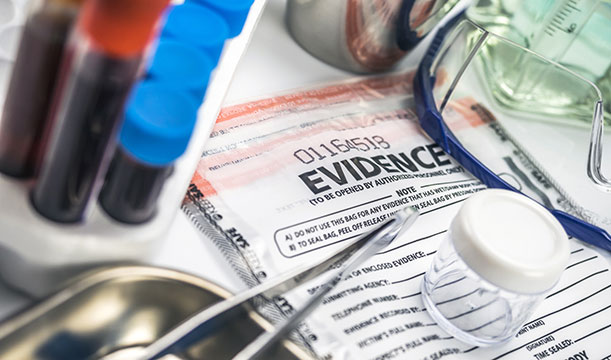BOOMbox at Home: Forensics Activities
December 15, 2020

Learn more about how investigators analyze evidence with these activities.
Fingerprints
Fingerprints are the patterns on our fingers, palms, and the soles of our feet formed by skin with little ridges. This skin provides friction to help us grip things better. We share fingerprints with other primates, as well as some other animals that evolved separately from us, like koalas. An important quality of fingerprints is that the patterns on this skin are unique to each individual. Although it’s impossible to prove it by sampling every fingerprint of every human who has ever lived, it’s widely accepted that no two humans have the exact same set of fingerprints, not even identical twins.
Because of the oils on our skin, we leave fingerprints behind on everything we touch. You can use forensic techniques like fingerprint dusting to find prints that have been left behind on an object. This works best on a smooth surface like glass. You need a brush, a powder like baby powder or cocoa powder, and clear tape. To get a good print, you can rub your fingers together to build up oil before you touch the glass. Then, dip your brush into your powder and dust the print, being gentle so you don't smudge it. The powder should cling to where you made the print. You can save your print by putting a piece of tape over it and peeling it off of the glass. If you want a less delicate way to look at your prints, you can also make them in clay. Fingerprints have been found on ancient Roman pottery.
Polygraphs and GSR
Ever wish you could know for sure whether your friend is trying to trick you? You may have seen lie detectors in movies, books, or on TV. In real life, these machines are called polygraphs. Unlike Pinocchio, our bodies don’t send an obvious signal when we aren’t telling the truth. But you may have noticed that when you lie, your heart races or your palms get sweaty. These changes are results of the activation of the sympathetic nervous system.
Polygraphs try to measure changes in blood pressure, breathing rate, and pulse to try to tell whether someone is lying. If a suspect has a stronger physical reaction to questions about a crime than they have to more neutral questions, the polygraph technician may infer that they are lying about the crime. However, some scientists question whether polygraphs are really accurate. One reason they are skeptical is that the responses being measured can be caused by things other than lying. For example, you might experience some of the same physiological changes when you’re nervous, which is a common reaction to high-stakes situations like being interrogated or trying to pass a security clearance. Nonetheless, polygraphs are still used by some law enforcement agencies, as well as employers in the federal government.
One of the measurements that is a part of polygraph tests is galvanic skin response (GSR). It measures how well your skin conducts electricity, which varies depending on how sweaty you are. You can use GSR to build your own basic “truth meter.” Try it out and experiment with simple circuits.
Chromatography
Want to find out if two notes were written with the same pen? You could try to tell just by looking, but the ink of most black pens looks pretty similar at first glance. Instead, find out for sure using chromatography, which is a technique scientists use to separate parts of a mixture. Since ink usually contains a mixture of dyes, you can use chromatography to match writing samples to the type of ink used to write them. Learn how to set up your own simple chromatography apparatus.
DNA Extraction
When you think of DNA extraction, you might think of medicine, advanced research, or even science fiction (Jurassic Park anyone?). But, DNA extraction is really simple. You can even do it at home using supplies that may already be in your kitchen. Sure, your strawberries and other snacks probably won’t be the key to any ongoing investigations, but this project relies on some of the same fundamental properties as real forensic tests. Try fun forensic activities for kids.
Person of the Week
Lacino Hamilton is a Black man from Detroit who was recently exonerated using DNA evidence after spending 26 years in prison. Hamilton was wrongfully convicted of second-degree murder and felony firearm charges in the death of his foster mother when he was only 19 years old. While still trying to cope with the loss of a beloved family member, he was sentenced to 50-80 years in prison for a crime he did not commit.
Throughout his entire experience with the judicial system, Hamilton maintained that he was innocent. He wrote thousands of letters to try to find attorneys willing to work on his case. Even after both the Wayne County Conviction Integrity Unit and Western Michigan University-Cooley Law School Innocence Clinic agreed to review his case, it took an additional 2 years for his conviction to be officially overturned. Now that he’s been released, Hamilton hopes to pursue a career in judicial reform to help protect others from wrongful conviction. You can learn more about attempts to prevent and reverse wrongful convictions from the Innocence Project.
Written by Eli, Frannie, and Veena.